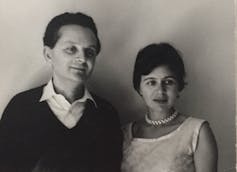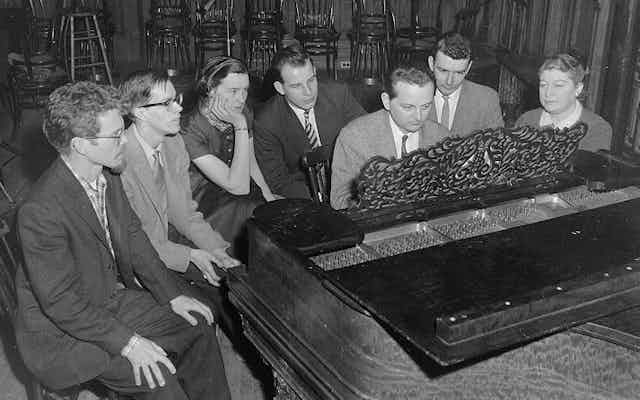In August 1943, while serving in a Jewish forced labour battalion, the Budapest-born composer Istvan Anhalt wrote a poem titled “Mirage in Elöpatak.” In this poem, Anhalt imagined a happier future:
“Strolling happy friends with wit abounding,
Thoughtfully smiling, invite you to join:
Come along, pal, if it suits you.”
He envisaged a place — Crystal City — where dreams of a better life would be fulfilled. This seemed an impossibly optimistic fantasy at the height of the Second World War.
But Anhalt did eventually reach that place. He immigrated to Canada, enjoyed a long career as a university professor, and found peace at home with his family in Kingston, Ont. From there he composed a significant body of compositions late in life.

He began his career as an avant-garde and pioneering electronic music composer, but later turned to a more traditional composition. His catalogue of works includes two dozen major pieces for voice, chamber ensemble and orchestra and several operas. Canadian pianist Glenn Gould recorded Anhalt’s composition Fantasia in 1967. In 2005, Anhalt’s Tents of Abraham won the Juno Award for best classical composition.
In 1985 he wrote to his friend, the American composer George Rochberg:
“It is remarkable how close Kingston comes to that imaginary community whose mirage filled me with hope and strength in 1943.”
But to get to Kingston, and to create his remarkable oeuvre, Anhalt first had to survive the horrors of the Holocaust.
Youth in Budapest
Anhalt was born in Budapest on April 12, 1919, into an assimilated Jewish family that was part of Hungary’s Neolog community, an expression of Reform Judaism.
Inspired by the example of his friend László Gyopár, who was a year older, Anhalt enrolled in the Franz Liszt Academy of Music in 1937. During his four years of studies, he was in one of the last classes taught by the famous composer and teacher Zoltán Kodály.
Despite thriving in his studies, Anhalt felt alienated from Hungarian society due to the increasingly severe anti-Jewish laws enacted between 1938 and 1941. The situation for Jews in Hungary became even more precarious in the summer of 1941, when Hitler forced Hungary to join in the attack on the Soviet Union.
Anhalt learned how dire his situation was in December 1942, when a notice in the mail summoned him to report for the Hungarian forced labour service.
The war years
Labour battalion conscripts were forced to do heavy physical labour for 10 to 12 hours per day, six or seven days a week. Anhalt’s company of about 250 men was stationed east of Hungary. His friend Gyopár was in the same unit but died in uncertain circumstances, perhaps murdered by a Hungarian overseer during a forced march in 1944.

While Anhalt was serving in the forced labour battalion, the genocide of the Hungarian Jews began. Nazi Germany invaded Hungary on March 19, 1944.
Two days later, Adolf Eichmann arrived in Budapest to oversee mass deportations to Auschwitz. During the final year of the war, about 70 per cent of Hungary’s 800,000 Jews would perish.
As the eastern front collapsed, Anhalt’s forced labour battalion marched westwards, one step ahead of the advancing Soviet Army. In November 1944, while his unit was heading towards Austria, Anhalt escaped and fled to a monastery. This move likely saved his life.
With the help of several people, including Catholic priest János Antal and the family of the cellist Jenő de Kerpely, Anhalt made his way back to Budapest and lived in hiding for the duration of the war.
Budapest in ruins
Emerging from hiding early in 1945, Anhalt discovered a city in ruins. He came across a sight that haunted him for the rest of his life. He describes the scene in A Weave of Life Lines, his unpublished memoir:
“On the roadway, half buried in the mud, lay a man wearing the uniform of a German soldier. I wanted to believe he was an SS murderer, flattened to a ‘pancake’ by a passing tank. But I cannot be certain. How much choice did he have in doing what he did? I came to associate that terrible sight in my mind with decision and the consequences that may accrue from it.”
Anhalt’s experiences during the war left their mark on his life in many ways. He was reluctant to speak his Hungarian mother tongue or associate with Hungarians. He suffered from recurring nightmares in which he was still trapped in a forced labour camp. And for decades, he did not speak of his wartime experiences.
New life in Canada
Anhalt was understandably anxious to leave Hungary after the war. He travelled to Paris in 1946, where he studied with teacher, conductor and composer Nadia Boulanger. Three years later, thanks to a scholarship for stateless intellectuals sponsored by philanthropist Lady Davis, he immigrated to Canada and went on to enjoy a rewarding and successful career as a professor of music.

Anhalt taught at McGill University from 1949 to 1971. In 1952, he married Beate Frankenberg (1924–2019), who had escaped with her family from her native Germany in 1939 to settle in Montréal; the couple had two daughters.
For Anhalt, Canada became his true home, rather than a place of exile. In 2008, he called Kingston “a true home, perhaps the first one I ever had.”
As he told musicologist and pianist Paul Helmer, “the greatest gift” he ever received was his landing card in Canada:
“I don’t need any pats on the back in addition to that …. All the rest that I did could be regarded as a partial payback for that landing card.”
Anhalt became nervous about living in Montréal during the October crisis of 1970, and so in 1971 he decided to move to Queen’s University to become head of the music department.
After retiring in 1984, he returned to composition with renewed vigour. In 1994 he dedicated his composition “Traces (Tikkun),” (not yet commercially recorded) to four of his classmates at the Liszt Academy of Music who perished in the Holocaust: László Gyopár, István Székely, Ödön Taubner and Lászlo Weiner.
During the 1990s, Anhalt took steps to honour those who had helped him to survive during the war. During a visit to Israel in 1992, he learned about the Yad Vashem memorial institute, and had János Antal and the de Kerpelys recognized as “Righteous among the Nations” for their efforts in saving his life.
He also had László Gyopár’s name added to the registry of those who died during the Holocaust. In 1994, through Anhalt’s efforts, Gyopár’s hour-long composition ‘Missa’ received its premiere in Budapest, 50 years after the composer’s death. It was a deeply meaningful occasion for Anhalt.
When I last met Anhalt in Kingston late in 2011, he ended our visit by saying: “All good things have an optimal endpoint.” I have a feeling he was referring not just to our meeting, but also his life. He passed away peacefully early in 2012, at the age of 92.

